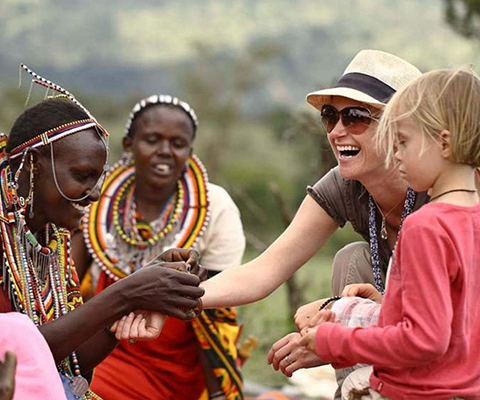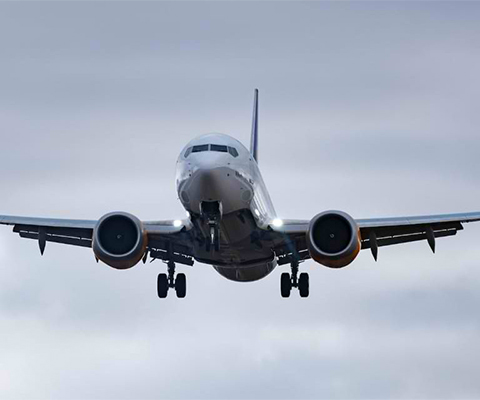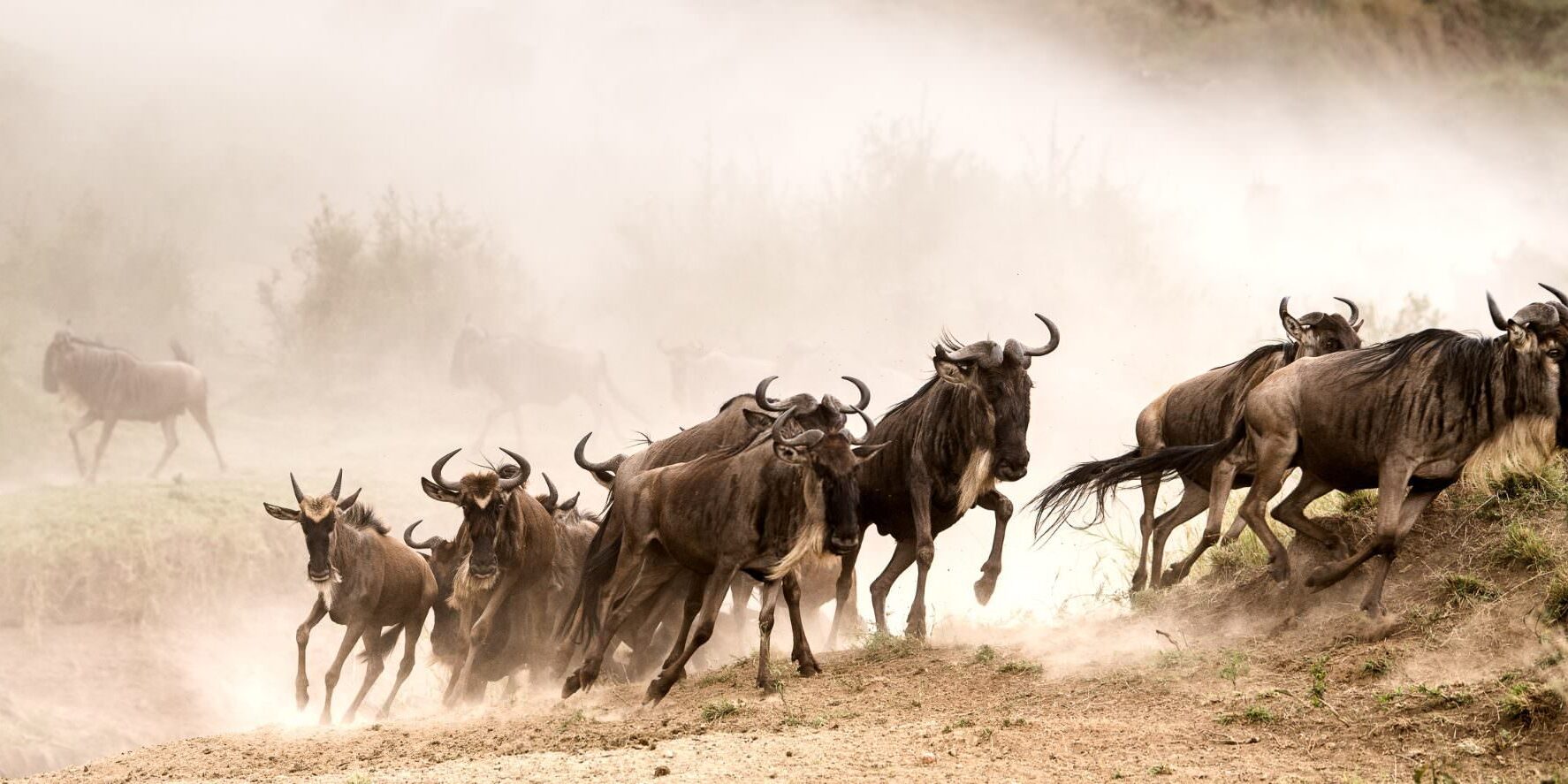The great wildebeest migration is an astounding natural spectacle, so phenomenal that it has been dubbed the greatest show on earth.
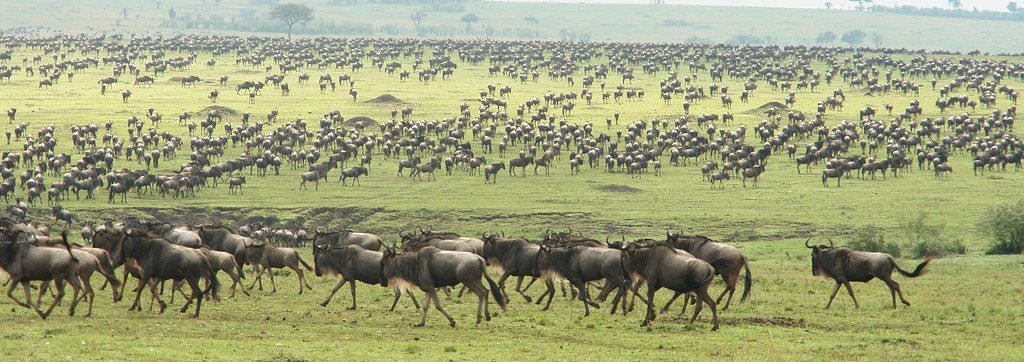
Each year, millions of wildebeest migrate across the greater Masai Mara — Serengeti ecosystem in what’s known as the great wildebeest migration. This immense movement is considered the world’s greatest wildlife spectacle and the Eighth Wonder of the World. And why wouldn’t it be? It’s beyond comprehension how millions of wildebeests, along with elands, zebras, Thompson’s gazelle, Grant’s gazelle, and impalas would migrate, against all odds from Kenya to Tanzania.
The great wildebeest migration is an experience that every wildlife or nature enthusiast wants to witness. It’s surreal. Nothing compares in scale to the massive numbers that constitute this migration. The animals follow the same route each year in search of water and grazing.
If you are planning to visit the Mara for the great wildebeest migration or are only interested in knowing what happens down there, this article is for you. First, we will discuss the great wildebeest migration in detail. Then I’ll take you through the moving migration maps plotting the migration pattern month by month. Finally, you’ll learn about the Masai Mara safari and the best time to visit. Here is an outline of the topics we’ll cover.
- What is the great wildebeest migration?
- The best place to witness the great wildebeest migration
- What month is the great migration in Kenya?
- What’s the best time to see the mara wildebeest migration?
- Why do wildebeest migrate to Kenya?
- Why do wildebeest need to migrate?
- What is the best time to visit Masai Mara?
- How much is a Masai Mara safari?
What is the great wildebeest migration?
The great wildebeest migration is, in fact, the largest migration of animals ever witnessed on earth. Over 1.5 million wildebeest accompanied by zebras, gazelles, and impalas migrate annually. They move in a cycle across the Mara-Serengeti ecosystem, searching for food and water. The wildebeests are guided by survival instinct, and they individually cover 800 to 1000 km while migrating from the Ngorongoro Conservation Area in Serengeti, Tanzania, to the Masai Mara in Kenya, and back again.
The great wildebeest migration is a classic example of survival for the fittest. The Mara river crossing, which is considered the climax of the great migration, will give you a wide range of emotions, including excitement, heartache, anticipation, and inspiration. The large herd of animals crossing the crocodile-infested river is a sight to behold. Crocodiles in the river attack their prey by clutching them with their jaws and dragging them underwater. Sometimes the crocodiles use their tails as a weapon. They then twist and smash their prey into bite-sized bits.
Prides of lion, cheetahs, wild dogs, hyenas, and leopards also attack the herd during the migration. Young calves are snatched from their parents, and the slow, weak, or exhausted are targeted, hunted down, and eaten. Some animals from the herd never make it because they drown in the river.
The organization the animals have during the great wildebeest migration is surprisingly impressive. They move in three groups, and each group sticks to their own kind. The first group normally eats the top of the tallest grass. The second eats the medium-height grass, and the last group eats what is left. When the herd has eaten all the grass, they move on.
Scientists are yet to figure out how the animals know the exact routes to follow. However, there are speculations that the animals simply follow the growth of new grass and the rains. A section of experts has speculated that the great wildebeest migration is a reaction to thunderstorms and lightning in the distance, up to 50 km away. Unfortunately, there is no scientific proof of the same.
The best place to witness the great wildebeest migration
There are two countries where you can witness the great wildebeest migration; Kenya and Tanzania. If you are at a loss on which country to visit, I hope this article helps you make an informed decision.
Kenya’s Masai Mara is the go-to option for many because it is easily accessible. You can fly from Nairobi to Masai Mara within a day. Although you can access Tanzania’s Serengeti, it is very isolated and may not be ideal for families. However, if you are the type of person that would want to enjoy quiet time while watching the great wildebeest migration, Serengeti would be ideal because very few people go there. You’ll get to enjoy the phenomenal spectacle on your own, or with very few other people.
If you decide to stay in Kenya as opposed to Serengeti, you have better chances of witnessing the river crossings. The Masai Mara route is also more concentrates compared to the Serengeti route.
Kenya is also a great choice because other than the great wildebeest migration, you can spot the Big Five animals i.e. lions, elephants, buffalos, rhinos, and leopards.
What month is the great wildebeest migration in Kenya?
There is no real beginning or end to the great migration because the herd is constantly on the move throughout the year. If you have never witnessed the great migration and want to, you may wonder what month is the wildebeest migration. Here is an overview of the months when you can witness the great migration of wildebeest and zebra in Kenya.
The great wildebeest migration: June and July
The dry season in Serengeti, Tanzania begins in June. Consequently, millions of wildebeest and their companions start herding towards the risky Mara river. The herd normally begins crossing the river in July, but the timings can vary depending on the weather.
Animals that successfully cross the Mara river can be seen in Kenya’s Masai Mara. You can also witness river crossings at the Talek and Mara rivers. If you want to witness the river crossings from afar, opt for camps close by where you can watch the great wildebeest migration from the camp’s main deck.
The great wildebeest migration: August to October
By August, wildebeest that successfully crossed the Mara river are spread across the Masai Mara. You are unlikely to witness any crossing during this period, but you can spot the herd moving eastwards.
The great wildebeest migration: November and December
The wildebeest face the risky Mara river once more in early November. They migrate from Kenya’s Masai Mara to Serengeti, past Namiri plains. You can witness the great wildebeest migration at the Masai Mara during this period. By late December, the migration is over and the wildebeest enjoy the lush grass and rain in Tanzania’s Serengeti. They begin to drift North West towards central Serengeti in May in preparation for the great migration in June.
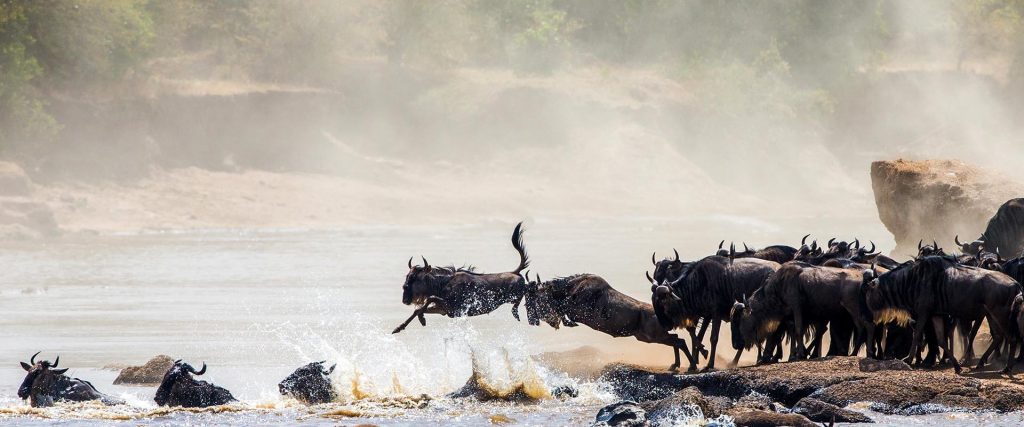
What’s the best time to see the mara wildebeest migration?
As discussed above, the best time to see the Mara wildebeest migration is between June and July and between November and December. In June, the wildebeest migrate from Tanzania to Kenya through the Mara and Talek rivers and in November, they migrate back to Tanzania following the same route they used.
The sole motivation of the great migration from Tanzania’s Serengeti to Kenya’s Masai Mara is greener pastures and rainfall. Masai Mara is an extension of the wildebeest grazing lands, so the wildebeests migrate when they need fresh pastures.
Why do wildebeest need to migrate?
The main reason why wildebeest migrate is to search for pasture and follow rainfall. The wildebeests are always on the lookout for lush green pasture. The great migration Kenya greatly depends on the rainfall, so although you may have a good idea of when the wildebeest will be at a certain time of the year, you can never be too sure.
What is the best time to visit Masai Mara?
The best time to visit Masai Mara is between June and October. You may spend more during this period because it is the peak season when most people want to experience the great wildebeest migration, but the experience will be worth every coin. You will leave the mara with lifelong memories.
How much is a Masai Mara safari?
A Masai mara safari is an experience of a lifetime. Therefore, the cost is a little above average. To determine how much a Masai Mara safari costs, you need to consider several factors including time of the year, accommodation, group size, mode of transport, duration of the safari, and park entry fees.
Time of the year
The cost of your safari is highly dependent on your travel dates. If you travel during the peak season, you will definitely spend more. The peak season is usually between July and November because this is the period the great wildebeest migration happens. Several people travel to the Masai Mara during this period, and the high demand causes a spike in the prices. You should consider visiting between January and March when the prices are lower.
During the high season you are likely to spend $300 per person sharing per day. This price is based on the assumption that two people would travel together in a safari Landcruiser.
Accommodation
Where you stay will also greatly influence the cost of your Masai Mara safari. Luckily, Masai Mara offers a wide range of accommodation options, so you can pick one that is within your budget. If you are on a tight budget, go for the adventure budget camping or mid-range safari lodges. If budget is not an issue, you can opt for the luxurious safari lodges.
During the low season, midrange safari lodges cost approximately US$ 150 per person per night. The price can go up to US$250 per person per night during the peak season. Luxurious tented camps cost roughly US$ 600 per person per night during the peak season and US$ 300per person per night during the low season.
Group size
If you travel in a large group, the safari will cost way less compared to when you travel alone or with one other person. You should consider traveling in a group to save some coins.
Mode of Transport
The mode of transport you choose will also influence the cost of your safari. If you take a flight from Nairobi to Masai Mara, you’ll spend between US$ 200 – 250 per person inclusive of taxes. The return flight will cost you between US$ 300- 450 per person.
Road transport is cheaper. If two people are traveling in a 4×4 Toyota Landcruiser, they will both pay between US$ 250 to 275. The price reduces if more people are traveling in the vehicle. Safari tour vans charge US$ 80 per person per day. The drive from Nairobi to Masai Mara is approximately 6 hours.
Duration of the safari
The duration of your safari will also determine how much you spend. For the full Masai Mara experience you should spend at least 4 days/3 nights at the game reserve. This way, you can schedule more game safaris.
Park entry fees
Entry fees is a requirement at the Masai Mara National Reserve. Adults staying at the national reserve pay US$ 70 every 24 hours and children pay US$ 40 per day. Adults staying outside the national reserve pay US$ 80 every 24 hours and children pay US$ 45 per day.
In conclusion, it would cost you approximately US$350 per day for a budget 3-day tour at the Masai Mara.
Where to stay in Kenya
If you visit Kenya specifically for the Masai Mara safari, you would have a better experience staying at a private conservancy. Hotels are a great option too, but keep it in mind that Kenya is a popular destination for the great migration safari so chances are that the hotels would be pretty crowded.
Private conservancies are mostly located on the north and east of the Masai Mara. They are separate from the game reserve and have beautiful surroundings. You get to choose a camp that would best suit your needs and avoid the crowds.
If you don’t mind crowds, you can book the hotels or opt for seasonal camps. The camps are usually set up between July and October.
Conclusion
The great wildebeest migration is an experience that every person needs to witness at least once in their life. It lives up to the hype of being one of the Seven Wonders of the World. You can experience the great migration from either Kenya or Tanzania. You should pick a place that would best suit your needs.
The greatest wildlife show on earth is definitely the great wildebeest migration. Purpose to experience it at least once in your life.


